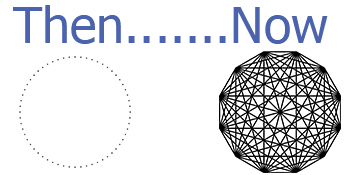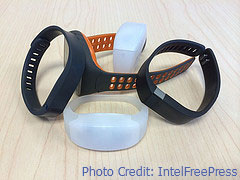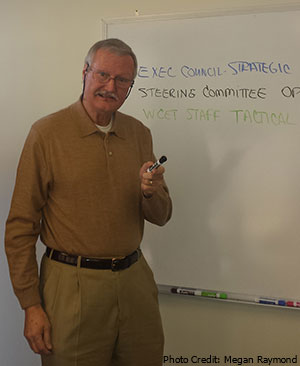Connecting the Dots
Published by: WCET | 1/14/2015
Tags: Access, Adaptive/Personalized Learning, Cost Of Instruction, Technology, WCET
Published by: WCET | 1/14/2015
Tags: Access, Adaptive/Personalized Learning, Cost Of Instruction, Technology, WCET
Today we welcome our new WCET executive director, Michael D. Abbiatti, to his first post on Frontiers. Many of you know Mike from his years of active participation as a member of WCET. We invite you to take a moment and read about the policy and practice challenges and opportunities he sees for WCET in 2015.
I recently attended our son’s graduation from the Texas A&M doctoral program in Pharmacy, and was treated to one of the best explanations of the unique value of our WCET policy and practice ecosystem as we enter 2015. A Texas Legislator, and a person with a clear vision for the future, presented the graduation address. The central message of her speech was that our collective mission in today’s complex world is to “connect the dots.” Needless to say, I was expecting a simple comparison to the children’ s coloring books that required drawing logical lines between dots to reveal a “hidden” image. The actual presentation was not only completely different, but also an inspiring treatise on the challenges we all face in the 21st Century Global Economy. The thoughts that follow are my adaptation of the “connecting the dots” theme in the context of the opportunities and challenges for WCET in 2015.

The old connecting the dots games were both fun and educational. In today’s world, we are obliged to concern ourselves with connecting a completely new set of dot categories, or domains, that may be connected in an endless number of patterns. Each pattern is unique to the personality and personal goals of the individual learner, and is also directly tied to the way each of us views our relationship to those around us. WCET members have the unique opportunity to work together to resolve the puzzles for collective benefit.
As an organization , we are presented with at least five critical “dots “ requiring connection in 2015:
Complex Regulatory Environment
We begin 2015 with a complex regulatory environment that includes new requirements for digital content delivery. State Authorization, Net Neutrality, data collection and reporting requirements, and new programs to support ubiquitous Internet access present a dynamic and poorly defined set of standards we must meet.
We can expect more rules as the Federal lawmakers delve deeper into higher education structure, function, and delivery methods. Therefore, our students are faced with trying to interpret this fluid policy environment in the context of their personal need and resources. A complicating fact is that learner populations are more numerous and diverse than ever.
Diverse Learner Communities
Although technology-enhanced education is not a new concept, we entered 2014 with a somewhat predictable mix between the traditional, campus-based student population and the “non-traditional”(whatever that means) off-campus learners.
In 2015, based upon the struggling economic recovery, the military drawdown, and a myriad of other life changing events, the demand for higher education is increasing significantly. Innovative experiments such as MOOCs have shown us that the chronological age and physical location of a given learner are no longer limiting factors when it comes to accessing needed content and skills. Furthermore, leaner populations continue to differentiate into those seeking concrete paths to traditional degrees (the “typical undergraduate and postgraduate students), learners seeking time-dependent employment certifications beyond IT ( healthcare, law enforcement, etc.), individuals and groups of all ages enrolling in free courses to secure specific information or to explore content (with or without intent to complete the course(s), i.e. the MOOC model), and an evolving series of sub-populations that are not yet defined.
Evolving Credentials
Interestingly enough, the credentials being sought by today’s learner populations are being redefined as well. In addition, the New Year will see the rise and fall of higher education credentials. We will see the life cycle of the mini-degree (i.e. the popular mini-MBA), the outcome of accumulation of “badges”(the Kahn Academy, or MIT Openstudy), the three year degree program that is at least on the minds of almost every state legislature, and a host of other creative approaches to decreasing the time requirement, cost (how much funding is needed to offer the education), price (what does a student pay) of higher education in the US. Thus, cost and price come to the forefront of the discussion.
Cost and Price Containment
2015 will see a continuation of the debate over funding for higher education at multiple levels. Federal interest in cost containment will bring about a host of both intended and unintended consequences that will eventually filter through the regions, the states, the systems, and the institutions to the pocketbooks of the individual learner. Students are concerned about the rising price of obtaining a higher education credential, and the accumulating debt associated with the process.
It is said that the Gen X students (born between 1965 and 1980) still value the more “traditional” college experience, but the Millenials (born after 1980), prefer to invest in “educational experiences” versus the physical trappings of the previous college offerings. As an active WCET member, you are well aware of the costs associated with providing fully immersive and interactive digital experiences in the “classroom” where ever it may be located. So, how do we lower price to the students and increase the value-add of the finished product? Perhaps the Internet of Things (IoT) phenomenon holds the answers to this complex question.
The Internet of Things (IoT) Phenomenon
 Simply defined for the purposes of this article, The Internet of Things (IoT) refers to connecting anything and everything that can be connected to the Global Internet. More specifically, at a recent IoT meeting in Louisville, KY we developed an operational definition of IoT as ubiquitous Internet-connected devices linking people, processes, and data. Interestingly enough, every segment of the global business community, except one, has an IoT strategy and ongoing trend analysis.
Simply defined for the purposes of this article, The Internet of Things (IoT) refers to connecting anything and everything that can be connected to the Global Internet. More specifically, at a recent IoT meeting in Louisville, KY we developed an operational definition of IoT as ubiquitous Internet-connected devices linking people, processes, and data. Interestingly enough, every segment of the global business community, except one, has an IoT strategy and ongoing trend analysis.
The one critical community without a clear IoT strategy in the US is Education.
Certainly we deal with Internet-related issues on a daily basis and we employ professionals who have the skills and passion to react to unintended events. However, do we have plans to deal with the costs and consequences of connecting all of the fixed and mobile devices on our campuses to the Internet? Are we prepared to absorb the costs for required infrastructure and security when we adopt the latest and greatest online teaching and learning tools for a global audience? What is the impact of leveraging OER, collaborative degrees, and high speed networks on our staff and support structures? In short, are we prepared to make good on the promises being made by IoT as those promises relate to providing access to affordable credentials?
Our students come to campus in an Internet-enabled car, carrying multiple Internet-dependent devices, expecting educational “experiences” that are both low cost and content rich. They invest in laptops, tablets, smartphones, fitbits, and will expect the latest and greatest tool in the classroom. The most important question for our WCET membership is, “Does your institution/system/state have an actionable IoT strategy?”
Connecting the Dots with WCET
So, back to connecting the dots. The “dots” of yesterday produce a predetermined image that is the same to every person who elected to pick up a pen and connect them. The result is wholly predictable. Connecting our new “dots” will produce an “image” that is totally individual and rapidly changing.
I challenge you to contact your WCET colleagues and resources and get busy “connecting the dots”! The outcome is completely up to you as an active member of the nation’s premier technology-enhanced education policy and practice organization – WCET!
WCET is on target, on task, and leaning forward to success in 2015 !

Michael D. Abbiatti
Executive Director – WCET
Vice President for Educational Technologies – WICHE
1 reply on “Connecting the Dots”
Mike….great opening points….Iwish you all the best; you have quite a challenge…I wish I were young enough to be by your side….I am in spirit anyway ?????